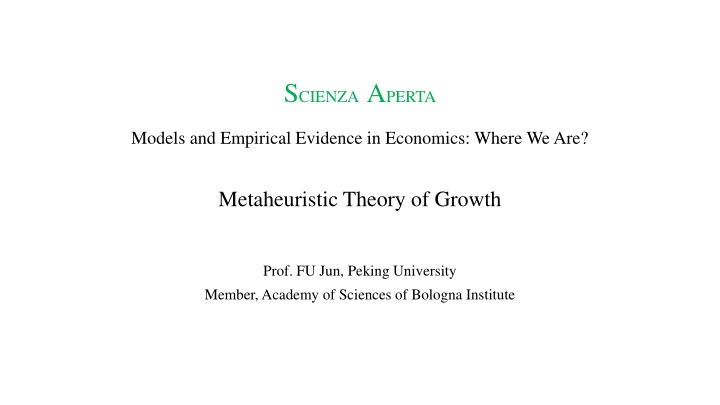SCIENZA APERTA
In this insightful study, Prof. Fu Jun explores the metaheuristic theory of growth in economics, examining different causes and integrating macro, mid-level, and micro analyses. The research delves into empirical tests and offers valuable insights and considerations for further development in the field. With a focus on simplicity, accuracy, and scope, this work sheds light on the intricate relationship between theoretical models and real-world data.
Download Presentation

Please find below an Image/Link to download the presentation.
The content on the website is provided AS IS for your information and personal use only. It may not be sold, licensed, or shared on other websites without obtaining consent from the author.If you encounter any issues during the download, it is possible that the publisher has removed the file from their server.
You are allowed to download the files provided on this website for personal or commercial use, subject to the condition that they are used lawfully. All files are the property of their respective owners.
The content on the website is provided AS IS for your information and personal use only. It may not be sold, licensed, or shared on other websites without obtaining consent from the author.
E N D
Presentation Transcript
SCIENZA APERTA Models and Empirical Evidence in Economics: Where We Are? Metaheuristic Theory of Growth Prof. FU Jun, Peking University Member, Academy of Sciences of Bologna Institute
Contents 1. 2. 3. 4. Central puzzle Modelling (metaheuristic theory) Empirical test Insight and caveat
2.1 Metaheuristic Theory of Growth: 4 Sets of Causes a) b) Contextual causes (institutional) c) Motivational causes (incentives) d) Ideational causes (idea gaps) Physical causes (tangible) From Newton to Einstein to biology to neuron science (low high resolution) Theory is to be judged by simplicity, consistency, accuracy, scope, and fruitfulness
2.3 Metaheuristic Theory of Growth in Integration h i K K K ( ) ( ) 1 1 G dt N H K P ( 1 )( )( ) t R I v i s i 1 1 K K , + where + = 1 ( ( ( 1 , 0 ) ) ) v i 1 , 0 K h i 1 , 0 K s i 1 , 0 K ( ( ) 1 , 0 ) R I This equation connects and integrates macro, mid-level, and micro analyses
2.4 Axiomatic Causes of Growth G = KN I From Homo Sapient to Homo Deus Truth is driven by simplicity Reality is ugly and needs to be reformed Art vs artwork
4. Insight and caveat a) b) Metaheuristic growth (inductive + deductive tinkering) c) | Stasis | order | complexity | chaos | d) Neo- (behavioralism + structuralism + evolutionism) e) Economics vs anthropology in globalization f) Rationality - Modernization is an unfinished agenda (Habermas) Theoria cum praxis (de-contextualize vs contextualize)
Grazie Empirical Data from: Economic Freedom Fields, Nobel, and Turing Prizes Freedom in the World (FIW) Human Development Index (HDI) International Property Rights Index Maddison Project Database OECD Data Polity IV Social Capital Survey World Development Indicators (WDI) World s 100k Top Scientists Worldwide Governance Indicators (WGI)

